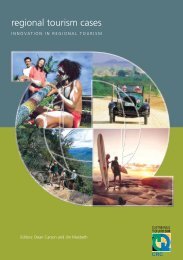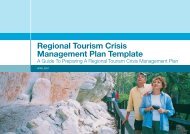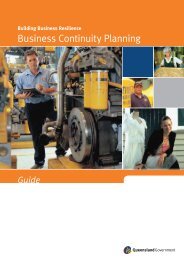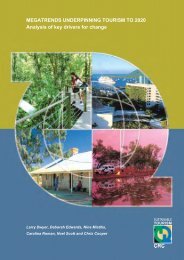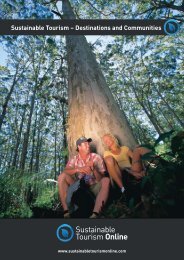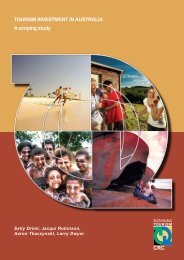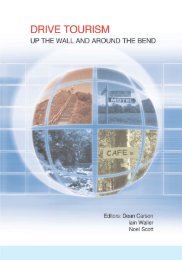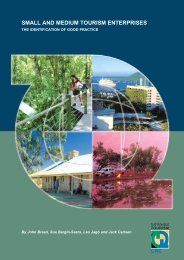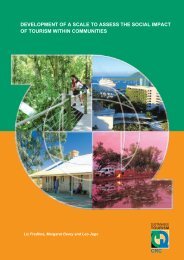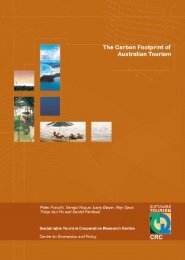The impacts of climate change on australian - Sustainable Tourism ...
The impacts of climate change on australian - Sustainable Tourism ...
The impacts of climate change on australian - Sustainable Tourism ...
You also want an ePaper? Increase the reach of your titles
YUMPU automatically turns print PDFs into web optimized ePapers that Google loves.
DEVELOPING ADAPTATION AND RESPONSE STRATEGIES—A SCOPING STUDY<br />
• Resources from government and private stakeholders.<br />
• Effective m<strong>on</strong>itoring and evaluati<strong>on</strong>—<str<strong>on</strong>g>climate</str<strong>on</strong>g> <str<strong>on</strong>g>change</str<strong>on</strong>g> is a moving target.<br />
Ec<strong>on</strong>omic <str<strong>on</strong>g>impacts</str<strong>on</strong>g> <str<strong>on</strong>g>of</str<strong>on</strong>g> <str<strong>on</strong>g>climate</str<strong>on</strong>g> <str<strong>on</strong>g>change</str<strong>on</strong>g> <strong>on</strong> tourism in the case study regi<strong>on</strong>s<br />
This project is the first that examines the likely flow-<strong>on</strong> effects <str<strong>on</strong>g>of</str<strong>on</strong>g> <str<strong>on</strong>g>climate</str<strong>on</strong>g> <str<strong>on</strong>g>change</str<strong>on</strong>g> <strong>on</strong> tourism activity, or in other<br />
words <str<strong>on</strong>g>climate</str<strong>on</strong>g> <str<strong>on</strong>g>change</str<strong>on</strong>g> induced tourism <str<strong>on</strong>g>impacts</str<strong>on</strong>g>, <strong>on</strong> the regi<strong>on</strong>al tourism ec<strong>on</strong>omies <str<strong>on</strong>g>of</str<strong>on</strong>g> Australia in the modelling<br />
framework <str<strong>on</strong>g>of</str<strong>on</strong>g> a fully bottom-up Computable General Equilibrium (CGE) Model. <str<strong>on</strong>g>The</str<strong>on</strong>g> project was developed in<br />
two stages, first to estimate the <str<strong>on</strong>g>impacts</str<strong>on</strong>g> <str<strong>on</strong>g>of</str<strong>on</strong>g> <str<strong>on</strong>g>climate</str<strong>on</strong>g> <str<strong>on</strong>g>change</str<strong>on</strong>g> al<strong>on</strong>e, and then from that basis the <str<strong>on</strong>g>impacts</str<strong>on</strong>g> <str<strong>on</strong>g>of</str<strong>on</strong>g> tourism<br />
<str<strong>on</strong>g>change</str<strong>on</strong>g>s were measured against the base case. <str<strong>on</strong>g>The</str<strong>on</strong>g> inputs in the first stage <str<strong>on</strong>g>of</str<strong>on</strong>g> the <str<strong>on</strong>g>climate</str<strong>on</strong>g> <str<strong>on</strong>g>change</str<strong>on</strong>g> effects were<br />
taken from the Garnaut Climate Change Review (Garnaut 2008).<br />
Results indicate that the ec<strong>on</strong>omy will be adversely affected, and more so in the sec<strong>on</strong>d half <str<strong>on</strong>g>of</str<strong>on</strong>g> the century<br />
than in the next decade. Overall, the ec<strong>on</strong>omy declines steadily over time, due to (a) the <str<strong>on</strong>g>climate</str<strong>on</strong>g> <str<strong>on</strong>g>change</str<strong>on</strong>g> effect <strong>on</strong><br />
productivity losses <str<strong>on</strong>g>of</str<strong>on</strong>g> labour, capital and intermediate inputs, and (b) loss <str<strong>on</strong>g>of</str<strong>on</strong>g> export demands from overseas as<br />
tougher internati<strong>on</strong>al competiti<strong>on</strong> against young developing countries increases. <str<strong>on</strong>g>The</str<strong>on</strong>g> loss <str<strong>on</strong>g>of</str<strong>on</strong>g> capital productivity<br />
makes the ec<strong>on</strong>omy relatively more capital intensive; thus investment becomes an important driver <str<strong>on</strong>g>of</str<strong>on</strong>g> growth.<br />
Coupled with the lower level <str<strong>on</strong>g>of</str<strong>on</strong>g> productivity, the loss <str<strong>on</strong>g>of</str<strong>on</strong>g> overseas exports results in a reducti<strong>on</strong> in domestic<br />
producti<strong>on</strong>, which subsequently reduces labour income and household c<strong>on</strong>sumpti<strong>on</strong>. In a comparis<strong>on</strong>, the<br />
adverse impact <str<strong>on</strong>g>of</str<strong>on</strong>g> <str<strong>on</strong>g>climate</str<strong>on</strong>g> <str<strong>on</strong>g>change</str<strong>on</strong>g> falls more <strong>on</strong> wage earners than <strong>on</strong> owners <str<strong>on</strong>g>of</str<strong>on</strong>g> capital.<br />
<strong>Tourism</strong> impact in the c<strong>on</strong>text <str<strong>on</strong>g>of</str<strong>on</strong>g> this project is an extensi<strong>on</strong> <str<strong>on</strong>g>of</str<strong>on</strong>g> <str<strong>on</strong>g>climate</str<strong>on</strong>g> <str<strong>on</strong>g>change</str<strong>on</strong>g> analysis, which explicitly<br />
attempts to measure the flow-<strong>on</strong> effect <str<strong>on</strong>g>of</str<strong>on</strong>g> <str<strong>on</strong>g>climate</str<strong>on</strong>g> <str<strong>on</strong>g>change</str<strong>on</strong>g> <strong>on</strong> tourism activity by applying guesstimates <str<strong>on</strong>g>of</str<strong>on</strong>g><br />
tourists’ resp<strong>on</strong>ses to losses <str<strong>on</strong>g>of</str<strong>on</strong>g> tourist attracti<strong>on</strong>. In the l<strong>on</strong>ger term, it is almost a case that losses <str<strong>on</strong>g>of</str<strong>on</strong>g> tourist<br />
attracti<strong>on</strong> imply losses <str<strong>on</strong>g>of</str<strong>on</strong>g> tourism demand.<br />
Lower demand for tourism has the effect <str<strong>on</strong>g>of</str<strong>on</strong>g> stimulating mining and manufacturing to expand their outputs<br />
and exports further. Given that the tourism sector is labour intensive, while mining and manufacturing are<br />
relatively more capital intensive, this diversi<strong>on</strong> <str<strong>on</strong>g>of</str<strong>on</strong>g> resources actually shifts the structure <str<strong>on</strong>g>of</str<strong>on</strong>g> the ec<strong>on</strong>omy toward<br />
being more capital intensive. <str<strong>on</strong>g>The</str<strong>on</strong>g> negative impact <strong>on</strong> wage earners is exacerbated.<br />
At the nati<strong>on</strong>al level, the total <str<strong>on</strong>g>of</str<strong>on</strong>g> <str<strong>on</strong>g>climate</str<strong>on</strong>g> <str<strong>on</strong>g>change</str<strong>on</strong>g> induced tourism <str<strong>on</strong>g>impacts</str<strong>on</strong>g> given in this report is insignificant,<br />
as this project examines <strong>on</strong>ly five out <str<strong>on</strong>g>of</str<strong>on</strong>g> many tourism destinati<strong>on</strong>s in Australia. If all destinati<strong>on</strong>s across<br />
Australia are taken into account, the nati<strong>on</strong>al impact would be very likely significant.<br />
At the regi<strong>on</strong>al level, tourism <str<strong>on</strong>g>impacts</str<strong>on</strong>g> are not distributed evenly across tourism destinati<strong>on</strong>s, as it largely<br />
depends <strong>on</strong> how tourism-reliant a destinati<strong>on</strong> is. <str<strong>on</strong>g>The</str<strong>on</strong>g> Victorian Alps regi<strong>on</strong> is the hardest hit regi<strong>on</strong>, because its<br />
tourism output shares 25% in the total output produced by the regi<strong>on</strong>; the sec<strong>on</strong>d hardest hit regi<strong>on</strong> is the<br />
Tropical North Queensland, with 13% <str<strong>on</strong>g>of</str<strong>on</strong>g> tourism share.<br />
It is important to note that the flow-<strong>on</strong> effects <str<strong>on</strong>g>of</str<strong>on</strong>g> <str<strong>on</strong>g>climate</str<strong>on</strong>g> <str<strong>on</strong>g>change</str<strong>on</strong>g> <strong>on</strong> tourism activity in fact are an endogenous<br />
factor in the <str<strong>on</strong>g>climate</str<strong>on</strong>g> <str<strong>on</strong>g>change</str<strong>on</strong>g> process. And it is these <str<strong>on</strong>g>climate</str<strong>on</strong>g> <str<strong>on</strong>g>change</str<strong>on</strong>g> induced tourism <str<strong>on</strong>g>impacts</str<strong>on</strong>g> that can <str<strong>on</strong>g>change</str<strong>on</strong>g> the<br />
actual impact level <str<strong>on</strong>g>of</str<strong>on</strong>g> <str<strong>on</strong>g>climate</str<strong>on</strong>g> <str<strong>on</strong>g>change</str<strong>on</strong>g> as a whole <strong>on</strong> a regi<strong>on</strong>. Results in Chapter 8 points out that Kakadu is the<br />
most affected regi<strong>on</strong> under the <str<strong>on</strong>g>climate</str<strong>on</strong>g> <str<strong>on</strong>g>change</str<strong>on</strong>g> effect al<strong>on</strong>e, the rest <str<strong>on</strong>g>of</str<strong>on</strong>g> Northern Territory and the rest <str<strong>on</strong>g>of</str<strong>on</strong>g><br />
Australia are the next two regi<strong>on</strong>s after Kakadu. However, when the <str<strong>on</strong>g>climate</str<strong>on</strong>g> <str<strong>on</strong>g>change</str<strong>on</strong>g> induced tourism <str<strong>on</strong>g>impacts</str<strong>on</strong>g> are<br />
c<strong>on</strong>sidered, Alpine Victoria and Tropical North Queensland (Cairns) are the most affected regi<strong>on</strong>s. As a result,<br />
<str<strong>on</strong>g>climate</str<strong>on</strong>g> <str<strong>on</strong>g>change</str<strong>on</strong>g> analysis, without further c<strong>on</strong>siderati<strong>on</strong> <str<strong>on</strong>g>of</str<strong>on</strong>g> its induced tourism impact, will very likely<br />
underestimate the total ec<strong>on</strong>omic costs to a regi<strong>on</strong> under <str<strong>on</strong>g>climate</str<strong>on</strong>g> <str<strong>on</strong>g>change</str<strong>on</strong>g> effects.<br />
Integrati<strong>on</strong> across case studies<br />
Comm<strong>on</strong> points across regi<strong>on</strong>s<br />
• Significant knowledge gaps around <str<strong>on</strong>g>climate</str<strong>on</strong>g> <str<strong>on</strong>g>change</str<strong>on</strong>g>, level <str<strong>on</strong>g>of</str<strong>on</strong>g> uncertainty and adaptati<strong>on</strong>.<br />
• Degree <str<strong>on</strong>g>of</str<strong>on</strong>g> scepticism in the community that <str<strong>on</strong>g>climate</str<strong>on</strong>g> <str<strong>on</strong>g>change</str<strong>on</strong>g> is associated with anthropogenic behaviour.<br />
• Better communicati<strong>on</strong> is needed across sectors, i.e. government, tourist industry, community and<br />
researchers, <strong>on</strong> the likely <str<strong>on</strong>g>impacts</str<strong>on</strong>g> <str<strong>on</strong>g>of</str<strong>on</strong>g> <str<strong>on</strong>g>climate</str<strong>on</strong>g> <str<strong>on</strong>g>change</str<strong>on</strong>g> and how to adapt to avoid duplicati<strong>on</strong>.<br />
• Need to c<strong>on</strong>sider the importance <str<strong>on</strong>g>of</str<strong>on</strong>g> the community in creating, influencing, and c<strong>on</strong>tributing to the sense<br />
<str<strong>on</strong>g>of</str<strong>on</strong>g> place and making tourism possible.<br />
• In all regi<strong>on</strong>s, tourism demand could be reduced by <str<strong>on</strong>g>change</str<strong>on</strong>g>s which affect the character <str<strong>on</strong>g>of</str<strong>on</strong>g> the landscape,<br />
the regi<strong>on</strong>’s ec<strong>on</strong>omy or the strength <str<strong>on</strong>g>of</str<strong>on</strong>g> community spirit.<br />
• Bigger operators were more likely than smaller operators to be planning and resp<strong>on</strong>ding to <str<strong>on</strong>g>impacts</str<strong>on</strong>g> by<br />
implementing adaptati<strong>on</strong> and mitigati<strong>on</strong> strategies. <str<strong>on</strong>g>The</str<strong>on</strong>g>y are more likely to have the resources to act, and<br />
may have a resp<strong>on</strong>sibility to shareholders to manage the risks <str<strong>on</strong>g>of</str<strong>on</strong>g> <str<strong>on</strong>g>climate</str<strong>on</strong>g> <str<strong>on</strong>g>change</str<strong>on</strong>g> <str<strong>on</strong>g>impacts</str<strong>on</strong>g>.<br />
xvi



